< Previous | Contents | Next >
King, Knight, and Poet
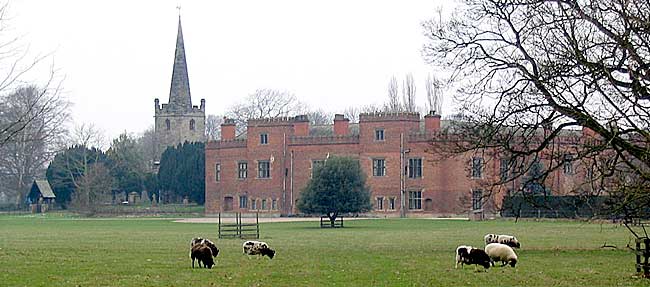
Holme Pierrepont Hall and church in 2004.
HOLME PIERREPONT. If the story is true which is here believed, a famous memory is enshrined in this village, delightful with quiet lanes, holly hedges, and great trees. Long the home of the Pierreponts, who became the Earls of Kingston, we found the great house silent, its ivied and embattled walls still charmingly grouped with the church.
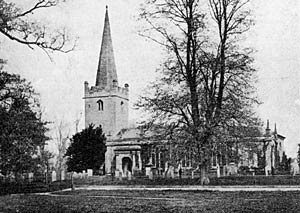
Holme Pierrepont church, c.1900.
The famous memory is of the founder of our Tudor dynasty, who is believed to have lodged here before the Battle of East Stoke which ended the pretensions of Lambert Simnel after the Wars of the Roses; Henry is said to have attended service in this church. He would see something that we see, though much is changed through rebuilding in the 17th century and restoration in the 19th. The massive tower and spire, the nave arcade with clustered pillars, and the great font are all 14th century, but the importance of the church is in its monuments, a fine group.
The oldest of all is a stone figure of an unknown civilian on the floor of the aisle. A battered alabaster knight is 14th century. The Sir Henry Pierrepont who fought against the Lancastrians in the Wars of the Roses and died in 1499 lies on a fine tomb, a knightly figure with long hair and a lovely collar of roses, his head on a helmet and his feet on a lion.
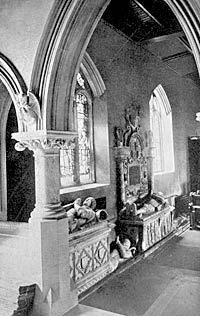 Pierrepont monuments in the church, c.1900.
Pierrepont monuments in the church, c.1900. Sir Henry of 1615 lies on the projecting tomb of his splendid alabaster monument, wearing armour and a ruff. Above him is a great display of heraldry with an epitaph telling us that his wife was a daughter of Bess of Hardwick. On the front of the tomb are seven small figures, an infant, five daughters, and a son who became the first Earl of Kingston. The story is told that the son, trying to remain neutral in the Civil War, prayed that if ever he took up arms for either side a cannon ball should divide him between the parties. It came to pass that he joined the King's side, was captured, and was cut in two by a chance shot from his own side as he was being taken by boat to Hull. He lies in Cuckney church.
There is a massive monument to a 17th century Countess of Kingston, describing her as "the illustrious Princess Gertrude." A plaque with a weeping woman by a draped urn is in memory of the second and last Duke of Kingston, Sir Evelyn Pierrepont who fought at Culloden and was one of the husbands of the notorious Elizabeth Chudleigh.
A sculpture by Flaxman of a woman reading a book is in memory of William Saltren, who was drowned while skating on Thoresby Lake, and a tablet on a pillar pays tribute to poor John Oldham, the young poet befriended by the Earl of Kingston. He lived through 30 exciting years of the 17th century, from 1653 to 1683, but he is not among the brilliant poets and his life can hardly be called a success. He was a Gloucestershire Nonconformist minister's son, a Tetbury grammar school boy, and spent some miserable years as an usher at Archbishop Whitgift's school at Croydon. He mixed too much with the unpleasant wits of his time and made a reputation by his satires (one of them against Virtue), and he was, as Pope called him, a very indelicate writer. He died here of smallpox, and he is chiefly remembered now because Dryden wrote a beautiful farewell to his memory beginning:
Farewell, too little, and too lately known,
Whom I began to think and call my own,
and ending by calling him the Marcellus of our tongue:
Thy brows with ivy and with laurels bound,
But fate and gloomy night encompass thee around.
The lychgate opening to the peaceful churchyard is a memorial of the Great War, and another echo of strife comes with the massive tomb of a Frenchman who fled from his country during the Revolution and lived many years in England.
Elizabeth and Her Husbands
HOVERINGHAM. It lies in the rich meadows by a fine reach of the Trent, where the ferryboat crosses to a thickly-wooded cliff crowned by Kneeton's church, set like a sentinel.
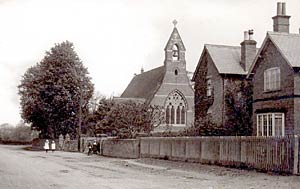
Hoveringham church, c.1910.
The small brick church has none of the beauty of the old one it replaced last century, but it has a few treasures. Built into the outside wall over the north doorway is a fine Norman tympanum showing St Michael flourishing his sword as he attacks two winged dragons with curling tails. He is defending the church (represented by a holy lamb) from its enemies; over his head is the Hand of God, and at the sides are Peter with a key and a bishop with his hand in blessing.
The font belongs to Norman and 13th century days, and was brought back to the church from the Ferry Inn last century. Set in a wall is part of an ancient coffin stone with the fine head of a cross carved in relief.
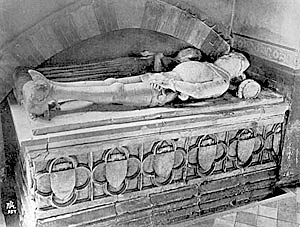 Tomb of Sir Robert Goushill and his wife.
Tomb of Sir Robert Goushill and his wife. On an alabaster tomb lie the battered but still fine figures of Sir Robert Goushill and his wife Elizabeth, the widowed Duchess of Norfolk. The knight, with a chest like a balloon, has plate armour, a pointed helmet, and an ornate belt with a flower on the buckle. His head is on his crest and his feet rest on an alert-looking dog with bells round its collar: he is wearing one of his gloves and holding the other. Eliabeth is a dainty lady in a mantle held by a cord and fine clasps, and covering a graceful gown. Her coronet is broken, her right arm is gone, and in the other hand she holds a tasselled cord; her pretty necklet, like a feathered chain, has a pendant. Her third husband was murdered after the Battle of Shrewsbury, and she married a fourth. Her father was the Earl of Arundel who was beheaded for treason in 1397; her second husband, the first Duke of Norfolk, who had been one of his accusers, was himself banished for treason.
